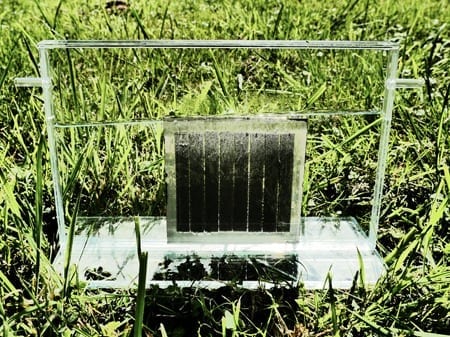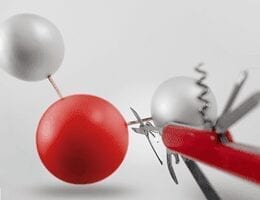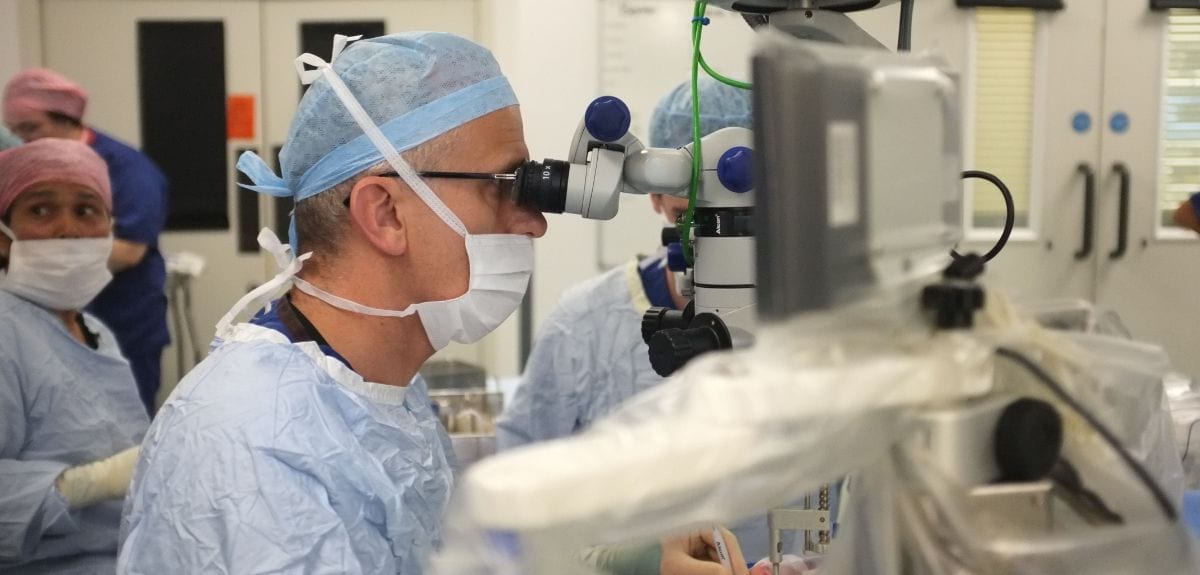
via: Forschungszentrum Jülich
Researchers create the first practical design for photoelectrochemical water splitting
Scientists from Forschungszentrum Jülich have developed the first complete and compact design for an artificial photosynthesis facility. This is a decisive step towards applying the technology. The concept is flexible both with respect to the materials used and also the size of the system. The researchers have now published their findings in the journal Nature Communications (DOI: 10.1038/NCOMMS12681).
In future, sun and wind will supply the lion’s share of our energy. The fluctuating nature of these renewable energy sources means that current research is focusing more intensively on efficient storage technologies. Like the energy sources themselves, these technologies should be environmentally friendly and affordable. This trend is particularly apparent in research on direct photoelectrochemical water splitting, that is to say artificial photosynthesis employing a combination of solar cell and electrolyser. In this way, solar energy can be directly converted into the universal storage medium of hydrogen. This process was first investigated in the 1970s, but has only begun to attract increasing attention in recent years. As yet, research has focused on materials science for new absorber materials and catalysts to further improve efficiency.
Jülich solar cell researchers Jan-Philipp Becker and Bugra Turan, however, are concentrating on an aspect that has so far largely been neglected: a realistic design that can take this technology from the scientists’ laboratories and put it into practical applications. “To date, photoelectrochemical water splitting has only ever been tested on a laboratory scale,” explains Burga Turan. “The individual components and materials have been improved, but nobody has actually tried to achieve a real application.”
Compact, complete, and expandable
The design created by the two experts from Jülich’s Institute of Energy and Climate Research is clearly different from the usual laboratory experiments. Instead of individual components the size of a finger nail that are connected by wires, the researchers have developed a compact, self-contained system – constructed completely of low-cost, readily available materials.
With a surface area of 64 cm2, their component still appears relatively small. The trick is in its flexible design. By continuously repeating the basic unit, it will in future even be possible to fabricate systems that are several square metres in size. The basic unit itself consists of several solar cells connected to each other by a special laser technique. “This series connection means that each unit reaches the voltage of 1.8 volt necessary for hydrogen production,” says Jan-Philipp Becker. “This method permits greater efficiency in contrast to the concepts usually applied in laboratory experiments for scaling up.”
Compatible with a wide range of technologies
At the moment, the solar-to-hydrogen efficiency of the prototype is 3.9 %. “That doesn’t sound like much,” admits Bugra Turan. “But naturally this is only the first draft for a complete facility. There’s still plenty of room for improvement.” In fact – the scientists add – natural photosynthesis only achieves an efficiency of one per cent. Jan-Philipp Becker is of the opinion that within a relatively short time the Jülich design could be increased to around 10 % efficiency using conventional solar cell materials. However, there are also other approaches. For instance, perovskites, a novel class of hybrid materials, with which it is already possible to achieve efficiencies of up to 14 %.
“This is one of the big advantages of the new design, which enables the two main components to be optimized separately: the photovoltaic part that produces electricity from solar energy and the electrochemical part that uses this electricity for water splitting.” The Jülich researchers have patented this concept, which can be flexibly applied for all types of thin-film photovoltaic technology and for various types of electrolyser. “For the first time, we are working towards a market launch”, says Becker. “We have created the basis to make this reality.”
Learn and see more: From Leaf to Tree: Large-Scale Artificial Photosynthesis
The Latest on: Large-Scale Artificial Photosynthesis
[google_news title=”” keyword=”Large-Scale Artificial Photosynthesis” num_posts=”10″ blurb_length=”0″ show_thumb=”left”]
via Google News
The Latest on: Large-Scale Artificial Photosynthesis
- The Advantages of Going Solaron April 29, 2024 at 9:33 am
This article explores the numerous advantages of adopting solar energy, both from an environmental standpoint and its capacity to influence economic and personal development.
- New dataset sheds light on relationship of far-red sun-induced chlorophyll fluorescence to canopy-level photosynthesison April 25, 2024 at 12:25 pm
In recent years, the scientific community has increasingly turned its attention to sustainable agriculture, aiming to maximize crop yield while minimizing environmental impact. A crucial aspect of ...
- Large Scale Eventson April 17, 2024 at 12:13 am
What kind of entertainment do you bring to campus? Everything! Music, comedy, hypnotists, trivia, bingo, Magicians etc. You name it, we've probably done it! Is there an admission charge? Most of our ...
- What Exactly Do Large Language Models Really Understand?on March 1, 2024 at 5:30 am
But Trager and Soatto suggest that large-scale models must "find their way" around their large "brains" to shed redundant information and improve relational discovery. By doing so, these models ...
- Artificial Photosynthesis: A Game Changer for Clean Energyon September 25, 2023 at 5:00 pm
that brings us a step closer to the day carbon dioxide could be used as a resource.
- Artificial leaves can now directly make liquid fuelson May 28, 2023 at 11:27 pm
The device, presented in the journal Nature Energy, is the latest evolution of an artificial ... large volumes of fuel, he says. “It is definitely possible to develop it in a large scale and ...
- Artificial Photosynthesis—Making Fuels Directly from Sunlighton May 13, 2022 at 5:40 pm
Nathan Lewis will present about the discovery and development of materials and a system architecture for the direct production of fuels from sunlight. The membrane-embedded microwire array approach is ...
- A new leaf unfolds in artificial photosynthesison February 27, 2022 at 3:27 am
In 2021, researchers from Toyota Central R&D Labs developed a large, cost-effective ... the company aims to establish artificial photosynthesis technology for wide-scale production of useful ...
- Fuel from sunlighton February 14, 2019 at 4:27 am
A new catalyst performs 'artificial photosynthesis' with increased efficiency – converting sunlight to hydrogen fuel, and bringing us one step closer to large-scale use of renewable energy. Solar ...
via Bing News










